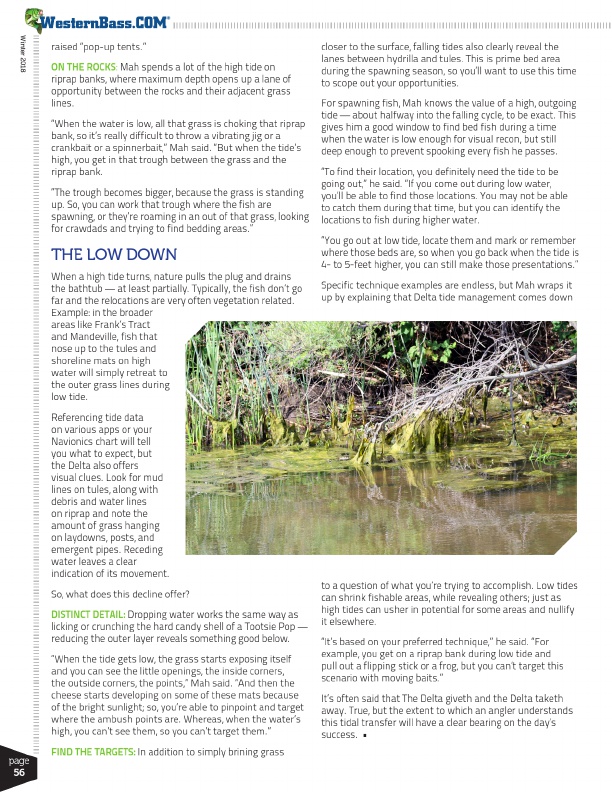
®
Winter 2018
page 56
raised “pop-up tents.”
ON THE ROCKS : Mah spends a lot of the high tide on riprap banks, where maximum depth opens up a lane of opportunity between the rocks and their adjacent grass lines.
“When the water is low, all that grass is choking that riprap bank, so it’s really difficult to throw a vibrating jig or a crankbait or a spinnerbait,” Mah said. “But when the tide’s high, you get in that trough between the grass and the riprap bank.
“The trough becomes bigger, because the grass is standing up. So, you can work that trough where the fish are spawning, or they’re roaming in an out of that grass, looking for crawdads and trying to find bedding areas.”
THE LOW DOWN
When a high tide turns, nature pulls the plug and drains the bathtub — at least partially. Typically, the fish don’t go far and the relocations are very often vegetation related. Example: in the broader areas like Frank’s Tract and Mandeville, fish that nose up to the tules and shoreline mats on high water will simply retreat to the outer grass lines during low tide.
Referencing tide data on various apps or your Navionics chart will tell you what to expect, but the Delta also offers visual clues. Look for mud lines on tules, along with debris and water lines on riprap and note the amount of grass hanging on laydowns, posts, and emergent pipes. Receding water leaves a clear indication of its movement.
So, what does this decline offer?
DISTINCT DETAIL: Dropping water works the same way as licking or crunching the hard candy shell of a Tootsie Pop — reducing the outer layer reveals something good below.
“When the tide gets low, the grass starts exposing itself and you can see the little openings, the inside corners, the outside corners, the points,” Mah said. “And then the cheese starts developing on some of these mats because of the bright sunlight; so, you’re able to pinpoint and target where the ambush points are. Whereas, when the water’s high, you can’t see them, so you can’t target them.”
FIND THE TARGETS: In addition to simply brining grass
closer to the surface, falling tides also clearly reveal the lanes between hydrilla and tules. This is prime bed area during the spawning season, so you’ll want to use this time to scope out your opportunities.
For spawning fish, Mah knows the value of a high, outgoing tide — about halfway into the falling cycle, to be exact. This gives him a good window to find bed fish during a time when the water is low enough for visual recon, but still deep enough to prevent spooking every fish he passes.
“To find their location, you definitely need the tide to be going out,” he said. “If you come out during low water, you’ll be able to find those locations. You may not be able to catch them during that time, but you can identify the locations to fish during higher water.
“You go out at low tide, locate them and mark or remember where those beds are, so when you go back when the tide is 4- to 5-feet higher, you can still make those presentations.”
Specific technique examples are endless, but Mah wraps it up by explaining that Delta tide management comes down
to a question of what you’re trying to accomplish. Low tides can shrink fishable areas, while revealing others; just as high tides can usher in potential for some areas and nullify it elsewhere.
“It’s based on your preferred technique,” he said. “For example, you get on a riprap bank during low tide and pull out a flipping stick or a frog, but you can’t target this scenario with moving baits.”
It’s often said that The Delta giveth and the Delta taketh away. True, but the extent to which an angler understands this tidal transfer will have a clear bearing on the day’s success. •